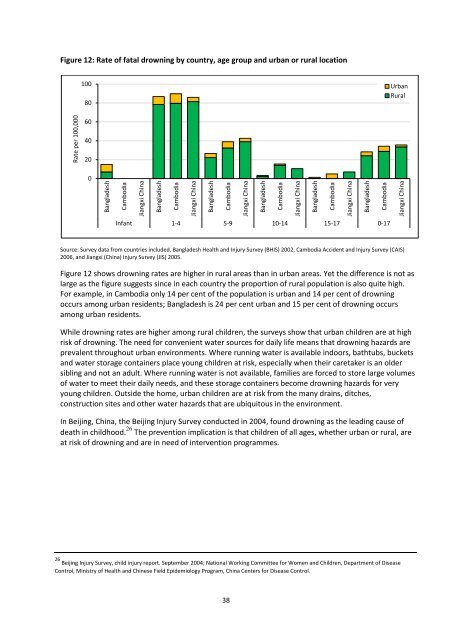Child Drowning
Child Drowning
Child Drowning
Create successful ePaper yourself
Turn your PDF publications into a flip-book with our unique Google optimized e-Paper software.
Bangladesh<br />
Cambodia<br />
Jiangxi China<br />
Bangladesh<br />
Cambodia<br />
Jiangxi China<br />
Bangladesh<br />
Cambodia<br />
Jiangxi China<br />
Bangladesh<br />
Cambodia<br />
Jiangxi China<br />
Bangladesh<br />
Cambodia<br />
Jiangxi China<br />
Bangladesh<br />
Cambodia<br />
Jiangxi China<br />
Rate per 100,000<br />
Figure 12: Rate of fatal drowning by country, age group and urban or rural location<br />
100<br />
80<br />
Urban<br />
Rural<br />
60<br />
40<br />
20<br />
0<br />
Infant 1-4 5-9 10-14 15-17 0-17<br />
Source: Survey data from countries included, Bangladesh Health and Injury Survey (BHIS) 2002, Cambodia Accident and Injury Survey (CAIS)<br />
2006, and Jiangxi (China) Injury Survey (JIS) 2005.<br />
Figure 12 shows drowning rates are higher in rural areas than in urban areas. Yet the difference is not as<br />
large as the figure suggests since in each country the proportion of rural population is also quite high.<br />
For example, in Cambodia only 14 per cent of the population is urban and 14 per cent of drowning<br />
occurs among urban residents; Bangladesh is 24 per cent urban and 15 per cent of drowning occurs<br />
among urban residents.<br />
While drowning rates are higher among rural children, the surveys show that urban children are at high<br />
risk of drowning. The need for convenient water sources for daily life means that drowning hazards are<br />
prevalent throughout urban environments. Where running water is available indoors, bathtubs, buckets<br />
and water storage containers place young children at risk, especially when their caretaker is an older<br />
sibling and not an adult. Where running water is not available, families are forced to store large volumes<br />
of water to meet their daily needs, and these storage containers become drowning hazards for very<br />
young children. Outside the home, urban children are at risk from the many drains, ditches,<br />
construction sites and other water hazards that are ubiquitous in the environment.<br />
In Beijing, China, the Beijing Injury Survey conducted in 2004, found drowning as the leading cause of<br />
death in childhood. 26 The prevention implication is that children of all ages, whether urban or rural, are<br />
at risk of drowning and are in need of intervention programmes.<br />
26 Beijing Injury Survey, child injury report. September 2004; National Working Committee for Women and <strong>Child</strong>ren, Department of Disease<br />
Control, Ministry of Health and Chinese Field Epidemiology Program, China Centers for Disease Control.<br />
38

















